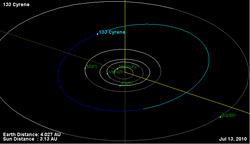Astronomy:133 Cyrene
 Orbital diagram | |
| Discovery | |
|---|---|
| Discovered by | James Craig Watson |
| Discovery date | 16 August 1873 |
| Designations | |
| (133) Cyrene | |
| Pronunciation | /saɪˈriːniː/[1] |
| Named after | Cyrene (nymph) |
| A873 QA; 1910 NB; 1936 HO; 1948 QC; 1959 UR | |
| Minor planet category | Main belt |
| Adjectives | Cyrenean /saɪrɪˈniːən/, Cyrenian /saɪˈriːniən/[2] |
| Orbital characteristics[3] | |
| Epoch 31 July 2016 (JD 2457600.5) | |
| Uncertainty parameter 0 | |
| Observation arc | 142.65 yr (52104 d) |
| |{{{apsis}}}|helion}} | 3.48274 astronomical unit|AU (521.010 Gm) |
| |{{{apsis}}}|helion}} | 2.64706 AU (395.995 Gm) |
| 3.06490 AU (458.503 Gm) | |
| Eccentricity | 0.13633 |
| Orbital period | 5.37 yr (1959.9 d) |
| Average Orbital speed | 17.03 km/s |
| Mean anomaly | 316.166° |
| Mean motion | 0° 11m 1.273s / day |
| Inclination | 7.21561° |
| Longitude of ascending node | 319.066° |
| 289.646° | |
| Earth MOID | 1.64415 AU (245.961 Gm) |
| Jupiter MOID | 1.65199 AU (247.134 Gm) |
| TJupiter | 3.206 |
| Physical characteristics | |
| Dimensions | 66.57±6.0 km |
| Mass | 3.1 × 1017 kg |
| Mean density | 2.0? g/cm3 |
Equatorial surface gravity | 0.0186 m/s² |
Equatorial escape velocity | 0.0352 km/s |
| Rotation period | 12.708 h (0.5295 d)[3] 12.707 h (0.5295 d)[4] |
| Geometric albedo | 0.2563±0.053[3] 0.2563[5] |
| Physics | ~133 K |
| S[5] | |
| Absolute magnitude (H) | 7.98,[3] 7.990[6] |
Cyrene, minor planet designation 133 Cyrene, is a fairly large and very bright main-belt asteroid that was discovered by J. C. Watson on 16 August 1873 in Ann Arbor, Michigan, and named after Cyrene, a nymph, daughter of king Hypseus and beloved of Apollo in Greek mythology.[7] It is classified as an S-type asteroid based upon its spectrum. It is listed as a member of the Hecuba group of asteroids that orbit near the 2:1 mean-motion resonance with Jupiter.[8]
In the Tholen classification system, it is categorized as a stony SR-type asteroid.[9] Photometric observations of this asteroid at the Altimira Observatory in 1985 gave a light curve with a period of 12.707 ± 0.015 hours and a brightness variation of 0.22 in magnitude. This result matches previous measurements reported in 1984 and 2005.[4]
References
- ↑ Noah Webster (1884) A Practical Dictionary of the English Language
- ↑ Cyrenean (3rd ed.), Oxford University Press, September 2005, http://oed.com/search?searchType=dictionary&q=Cyrenean (Subscription or UK public library membership required.)
- ↑ 3.0 3.1 3.2 3.3 Yeomans, Donald K., "133 Cyrene", JPL Small-Body Database Browser (NASA Jet Propulsion Laboratory), https://ssd.jpl.nasa.gov/sbdb.cgi?sstr=133, retrieved 12 May 2016.
- ↑ 4.0 4.1 Buchheim, Robert K. (June 2006), "Photometry of asteroids 133 Cyrene, 454 Mathesis, 477 Italia, and 2264 Sabrina", Astronomy and Astrophysics Supplement Series 33 (2): pp. 29–30, Bibcode: 2006MPBu...33...29B.
- ↑ 5.0 5.1 Richmond, Michael (1 March 2001), "Asteroid Lightcurve Data File", Astronomy and Astrophysics Supplement Series, http://spiff.rit.edu/richmond/parallax/phot/LCSUMPUB.TXT, retrieved 2013-03-29.
- ↑ Pravec, P. et al. (May 2012), "Absolute Magnitudes of Asteroids and a Revision of Asteroid Albedo Estimates from WISE Thermal Observations", Asteroids, Comets, Meteors 2012, Proceedings of the conference held May 16–20, 2012 in Niigata, Japan (1667), Bibcode: 2012LPICo1667.6089P.
- ↑ Schmadel, Lutz D.; International Astronomical Union (2003), Dictionary of minor planet names, Berlin; New York: Springer-Verlag, p. 27, ISBN 978-3-540-00238-3, https://books.google.com/books?id=VoJ5nUyIzCsC&pg=PA27.
- ↑ McDonald, Sophia Levy (June 1948), "General perturbations and mean elements, with representations of 35 minor planets of the Hecuba group", Astronomical Journal 53: p. 199, doi:10.1086/106097, Bibcode: 1948AJ.....53..199M, http://adsabs.harvard.edu/cgi-bin/nph-data_query?bibcode=1948AJ.....53..199M&link_type=ARTICLE&db_key=AST&high=.
- ↑ DeMeo, Francesca E. et al. (July 2009), "An extension of the Bus asteroid taxonomy into the near-infrared", Icarus 202 (1): pp. 160–180, doi:10.1016/j.icarus.2009.02.005, Bibcode: 2009Icar..202..160D, archived from the original on 2014-03-17, https://web.archive.org/web/20140317200310/https://www.tara.tcd.ie/bitstream/2262/43276/1/PEER_stage2_10.1016/j.icarus.2009.02.005.pdf, retrieved 2013-04-08. See appendix A.
External links
- 133 Cyrene at AstDyS-2, Asteroids—Dynamic Site
- 133 Cyrene at the JPL Small-Body Database
 |

